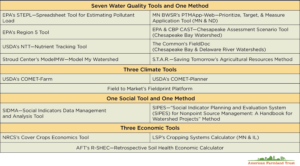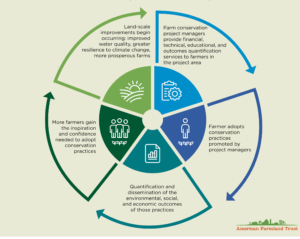Advancing the adoption of conservation practices and keeping farmers viable is a fundamental goal of the farm conservation community. This community includes producers and landowners, farm and environmental groups, agricultural retailers and crop consultants, government representatives at federal, state, and local levels, academics, supply chain sustainability leaders, environmental market developers, research and charitable foundations, etc. Together, this diverse community supports farmers in reducing unintended environmental effects of agriculture through educational, financial, and technical assistance projects to adopt conservation practices. These practices can result in improved soil health, better water quality, reduced greenhouse gas emissions, a boost to the farmer’s bottom line, and other benefits.
Quantifying these outcomes is important because it’s a powerful tool to help the local conservation community “sell” conservation to producers better, faster, and across more acres. However, the community struggles to quantify their project outcomes due to a lack of knowledge about which direct monitoring or indirect modeling estimation methods, models, or tools they should use. This is in part because there are numerous options available and finding the right one can be daunting. Furthermore, actually conducting the monitoring, modeling, or using an outcomes estimation tool can be very hard.
To help project managers achieve this essential step, AFT identified, described, and compared readily available outcomes quantification tools and methods.
- With this information AFT created the Outcomes Estimation Tools Guide to educate conservationists and empower project managers to select one or more tools/methods to meet their project outcomes quantification goals.
- AFT also partnered with the tool developers to bring this information to project managers in the form of an outcomes estimation tools training webinar series.



